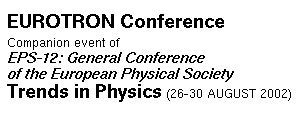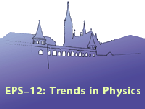 |
 |
 |
An intense, high-energy electron or positron beam can have focused intensities rivaling those of today's most powerful lasers. For example, the 5 ps (FWHM), 50 GeV beam at the Stanford Linear Accelerator Center at 1 kA and focused to a 3 micron rms spot size gives intensities of > 1020 W/cm-3 at a repetition rate of 10 Hz. Unlike a ps or fs laser pulse, the particle beam can readily bore through several mm of steel due to the rigidity of its flux component. However, the same particle beam can be manipulated quite strongly by a plasma that is a million times less dense than air! This is because of the incredibly strong collective fields induced in the plasma by the Coulomb force of the beam. The collective fields in turn react back onto the beam leading to many clearly-observable phenomena. The beam can be: (1) deflected leading focusing, defocusing, or even steering of the beam; (2) undulated causing the emission of spontaneous betatron x-ray radiation and; (3) accelerated or de-accelerated by the plasma fields. Using the 28.5 GeV electron beam from the SLAC linac we have carried out a series of experiments that demonstrate clearly many of the above mentioned effects. The results are compared with theoretical predictions and 2D and 3D, one-to-one, PIC code simulations. These phenomena may have practical application in future technologies including optical elements in particle beam lines, synchrotron light sources, and ultra-high gradient accelerators.
The following files are available:
- abstractjoshi.pdf [8869 bytes]
- abstractjoshi.doc [43008 bytes]
Eurotron Conference is supported by European Commission, High-Level Scientific Conferences